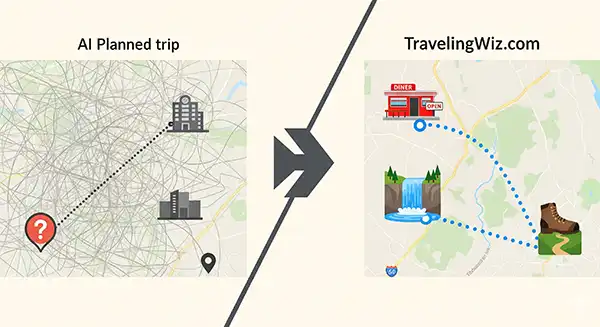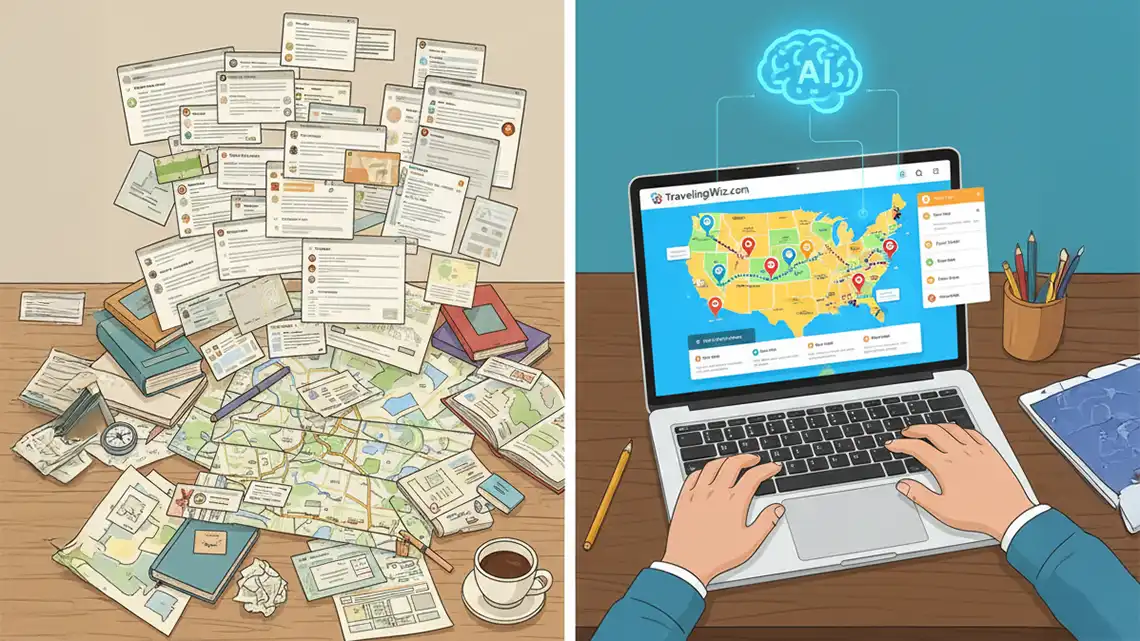Tired of juggling endless browser tabs, guidebooks, and scattered notes when planning a trip? You’re not alone. The real magic of travel lies in discovering unique places – but finding them can feel overwhelming when the internet is overflowing with “Top 10” lists and generic recommendations.
That’s where AI for Travel Planning comes in. Used wisely, it can cut through the noise and help you create a trip that’s authentic, personal, and memorable. But here’s the catch: not all AI tools are equal. Generic AI can provide a starting point, but it often offers incomplete or incorrect information. Specialized tools, like TravelingWiz.com, take it a step further by connecting you with curated guides, local insights, and tailored itineraries.
Let’s dive into how to use AI for travel planning in 2025 – and when to trust it, refine it, or ditch it for better alternatives.
Why Travelers Are Using AI in 2025
AI for Travel Planning has gone mainstream. From writing work emails to planning weekly meals, people use it daily to save time, and travel is no exception.
A recent Booking.com Global AI Sentiment Report (2025) found that 67% of travelers have already used AI in some part of their trip planning, and a striking 89% want to use AI for future travel. Enthusiasm is at 91% worldwide, but trust is mixed — only 6% of consumers fully trust AI to make decisions independently. This shows the excitement around AI travel planning, but also why travelers need to be cautious about relying on generic tools.
Recent surveys confirm just how significant this shift is:
- Over 60% of Millennials and Gen Z in key markets now use generative AI for trip planning.
- A global study found that 89% of consumers worldwide want to use AI for their future travel plans.
- In some reports, travelers even rate AI as more reliable than traditional human travel advisors.
The appeal is obvious: instead of juggling 20 browser tabs, you ask a tool and get an instant itinerary. But while adoption is skyrocketing, so is the need to understand the limitations.
1. Start with Inspiration
AI shines when you’re at the “where should I go?” stage. You can feed it prompts like:
- “Suggest five underrated European destinations for food lovers in spring.”
- “Where can I travel in Asia for under $1,500 with great hiking and local markets?”
It will instantly give you a shortlist of ideas, saving hours of random Google searches.
However, here’s the problem: generic AI may suggest options that don’t fit your needs (such as budget, accessibility, age, travel style, or activity type), or worse, that don’t make sense (such as recommending winter sports in July). Always cross-check the basics before committing.
2. Generate a Rough Itinerary
Once you’ve chosen a destination, AI can build a structure: what to do each day, which areas to explore, and how long to spend at each spot.
Example prompts:
- “Create a 5-day itinerary in Portugal focused on beaches and culture.”
- “Plan a 7-day Japan trip for first-timers that includes Tokyo, Kyoto, and Osaka.”
This provides a rough draft for you to work with. Think of it as your canvas, not the final masterpiece.
3. Spot the Flaws in Generic AI
Here’s where travelers need to be careful. Generic AI tools are notorious for:
- Recommending attractions that don’t exist or are permanently closed.
- Mixing together outdated information from old blogs.
- Suggesting chains instead of authentic local businesses.
This is why relying only on generic AI is risky. It’s like asking a stranger who’s “heard of a place once“ instead of getting advice from someone who’s actually been there.
4. Example: AI in Action
Let’s make this real with a step-by-step scenario.

Prompt to a generic AI:
“Plan a 5-day road trip from Seattle to Yellowstone. I enjoy hiking, unique diners, and historical sites. Keep it scenic.”
Likely AI Response:
- Suggests big-name stops like Spokane and Missoula
- Includes a few hiking trails and one or two generic restaurant recommendations
- Possibly throws in a “hidden gem“ that doesn’t exist
Helpful? Sure. Perfect? Not quite.
How TravelingWiz.com handles it:
- Find ideas for your next adventure based on your needs
- Creates a day-by-day itinerary with scenic drives and real verified stops
- Adds local food recommendations from curated guides, not just chains
- Notes practical details like drive times, parking, or whether a trail is family-friendly
- Suggests optional extras like hot springs or small-town festivals
- Offer location-specific tips
- Offer relevant events
- Connect you with local guides for help planning or booking your trip
👉 Ready to make it happen? Try Wizzy – TravelingWiz.com AI trip planner and let AI plan your next adventure the smart way.
5. Mix AI for Travel Planning with Local Resources
Even the best AI isn’t a replacement for human insight. That’s why blending AI results with local event calendars, tourism boards, consulting with local guides, and niche blogs creates the perfect combo.
- AI gives you the framework.
- Locals and curated guides give you the heart and soul.
At TravelingWiz.com, each itinerary isn’t just AI-driven — it’s enriched with real travel guides, must-try foods, and cultural tips.
6. Save Time, But Leave Room to Wander
AI is a time-saver, but don’t let it box you in. Always leave space in your itinerary to just wander. Take the tram to the last stop, walk a street you’ve never seen before, or follow your nose to a food stall.
Sometimes the best discoveries come from unplanned moments. AI should give you freedom, not rigidity.
Conclusion + CTA
Travel planning doesn’t have to be overwhelming or time-consuming. With the right approach, AI can be your shortcut to discovering hidden gems, creating efficient itineraries, and planning unforgettable trips.
Finding hidden gems doesn’t have to be hard. With a mix of local tips, deeper research, and an innovative tool like TravelingWiz.com trip planner, you can plan trips that are personal, surprising, and truly unforgettable.
👉 Ready to uncover your next hidden gem? Stop planning like a tourist and start traveling like a local. Try TravelingWiz.com now and let AI plan your perfect trip in minutes.
Can I trust AI to plan my entire trip?
No. While AI is a powerful tool for generating ideas and creating a rough itinerary, it’s not foolproof. AI can provide outdated information, miss critical details like visa requirements, or even make things up entirely. You should always cross-check key information with reliable sources.
What’s the main advantage of using AI instead of traditional research?
AI saves time. Instead of browsing dozens of blogs, review sites, and forums, AI can instantly filter destinations, itineraries, and activities based on your preferences. This lets you focus more on enjoying the planning process instead of getting overwhelmed.
How do AI trip planners like TravelingWiz.com differ from ChatGPT or other generic tools?
Be specific! Instead of a broad prompt like “plan a trip to Italy,” try, “Plan a 7-day Italy itinerary focusing on food and history, spending 3 days in Rome and 4 in Florence. I’m a vegetarian.” The more details you provide, the better the result.













Buy a compatible power adapter for your trip